Researchers from the University of Oxford and Ca’ Foscari University of Venice teamed up with students and staff at Cheney School, and with visual and performing artists, to create a festival of writing—with a special focus on elements of writing systems that exist between, around, or on top of the words themselves, and help us read “between the lines” (emojis, quotation marks, colour, layout, cartouches in Egyptian hieroglyphs, and much more….). We were delighted to welcome over 300 participants.
From the University of Oxford, Caolan O’Neill—assisted by Sam McKee—brought activities on all things emoji, including an emoji quiz. Younger competitors were the hands-down champions!

At Jeff Yip and Philomen Probert’s stall, participants created a collaborative display on quoting and related concepts. Jeff and Philomen learnt a lot from discussions that took place here—including different ways of using a phrase without really “believing” in it, in different spoken and signed languages.
Can anyone answer the riddle about goose’s feet?

Chloé Agar, Hana Navratilova, Christian Sanders, and Jesse Smale invited participants to write like an ancient Egyptian, in hieroglyphics—or to decipher a text written in hieroglyphics, in a language that turned out to be English!
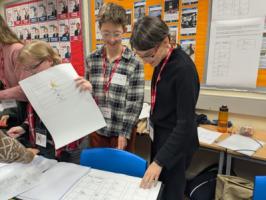
At Gustavo Fernandes Pedroso’s stall, participants got to write like a Babylonian, in cuneiform:
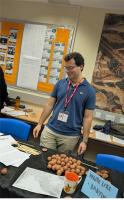
Philomen’s effort at this one, with apologies to all cuneiform specialists everywhere! Ancient Babylonian scribes and Gustavo somehow manage to pack much more writing than this onto a small clay tablet…
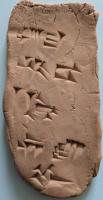
Michele Bianconi, Melanie Rowntree, Althea Sovani, Sophie Stone, Renee Trepagnier, and Daniel Whittle brought activities on the Linear B script, with which the Greek language was written around 1400 to 1200 BC:
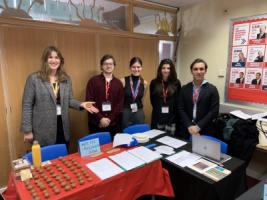
Florencia Nelli (University of Oxford and Communicate Project) brought activities on the Cypriot syllabic script—a writing system indirectly related to the Linear B script but used many centuries later, on Cyprus:
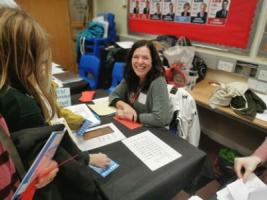
While the Cypriot syllabic script was in use on Cyprus, Greek-speakers outside Cyprus were writing Greek in a completely different script, the Greek alphabet. The Greek alphabet forms part of the history of our own (“Roman” alphabet), which participants got to explore with Isabel Doherty and Fiona Phillips.
Annick Payne (Ca’ Foscari University of Venice), Emanuele Alleva (Ca’ Foscari University of Venice), and Lucy Jones (University of Oxford) teamed up to offer activities on writing systems of ancient Anatolia, and activities on how our brains make sense of squiggles. How do these become sentences in a language, for instance English?

Actors Hannah Barrie, Ursula Early, and Matthew Spencer performed a ten-minute play written by Philomen Probert (University of Oxford) and directed by actor Paul O’Mahony. The main character was an emoji, on a quest to prove that emojis have existed for centuries…but no easy answers to this question emerged!
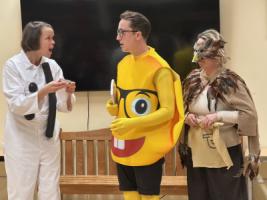
Each of the three performances was followed by a panel discussion with researchers. Audiences had very good and challenging questions for us!

In this post-performance pic, Ursula Early as Hawk meets Annick Payne (Ca’ Foscari University of Venice and AWRC Visiting Scholar, Wolfson College Oxford), whose work inspired the character of hawk. They are holding the Luwian name of the goddess Kubaba—in the dative, just for the record, although the play didn’t go into that!

Other aspects of the play were inspired by the research of Jieun Kiaer (University of Oxford), Julian J. Schlöder (University of Connecticut), Daniel Altshuler (University of Oxford), Adam Gitner (Bayerische Akademie der Wissenschaften, Thesaurus linguae Latinae), Evina Stein (https://homomodernus.net/about/). Alan Avdagić (MA student, Julius-Maximilians-Universität Würzburg) acted as invaluable zoomer consultant!
School students brought a magnificent range of activities around the event’s theme, under the aegis of the Rumble Museum Councils—groups of students who meet every week to work with museum director Dr Lorna Robinson on exhibitions, curation, projects, and events. Their activities included codes, ciphers, and languages in favourite shows and movies; Japanese calligraphy, and the history of Japanese; names and their etymologies; Aztec writing; euphonics, community poems, and literary devices; pictograms; cave paintings; finding the Minotaur; making a bookmark with an ancient script; drawing an emoji on a clay tablet; and a quiz show on writing systems and symbols:

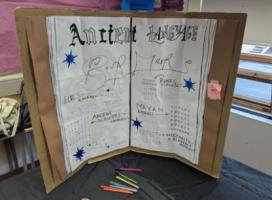

In addition to finding the Minotaur, the event featured a feast of words and images on the ancient Minoan world. Myth and Voice Initiative (Royal Holloway, University of London) invited participants’ creative use of words, images, or both—with inspiration from the new novel Flower Gatherers by Cheney’s own Dr Lorna Robinson!
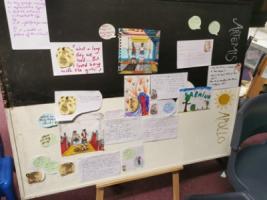
The Bodleian Library brought a hand printing press for printing a labyrinth:

Under the expert guidance of mosaicist Clare Goodall, participants created a mosaic based on the saffron gatherers fresco from ancient Akrotiri.
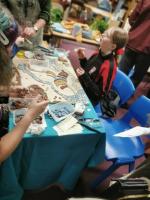
Dancers Nikki Skinner and Em-J Smith brought Minoan dancing beautifully to life, and face-painter Carole Hooper painted participants’ faces with emojis, as modelled here by History teacher Mr David Gimson:
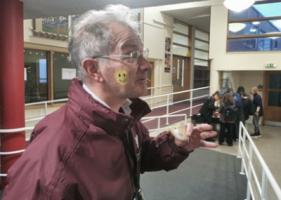
The event was topped off by a circus act, by street performer Jonathan Russell. Reading their faces “between the lines”, we thought some of the teachers were slightly nervous when we got to this part 🙂.
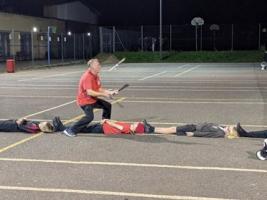
With the help of Cheney school students and Iona Blair (University of Oxford), participants left us feedback that was both creative and honest!

This project has been generously supported by the University of Oxford’s PCER Fund; the Philological Society; the TORCH Performance Research Hub (University of Oxford); the Faculty of Classics (University of Oxford); the Faculty of Linguistics, Philology & Phonetics (University of Oxford); Wolfson College, Oxford; the Institute of Classical Studies; the General Fund for Assyriology (University of Oxford); the Iris Project; the Myth and Voice Initiative; and the Society for the Promotion of Hellenic Studies. Annick Payne and Emanuele Alleva’s participation in this event was courtesy of the ERC project CAncAn: Communication in Ancient Anatolia (grant no. 101088363).
We are hugely grateful to all our sponsors and to everybody who was part of this event.